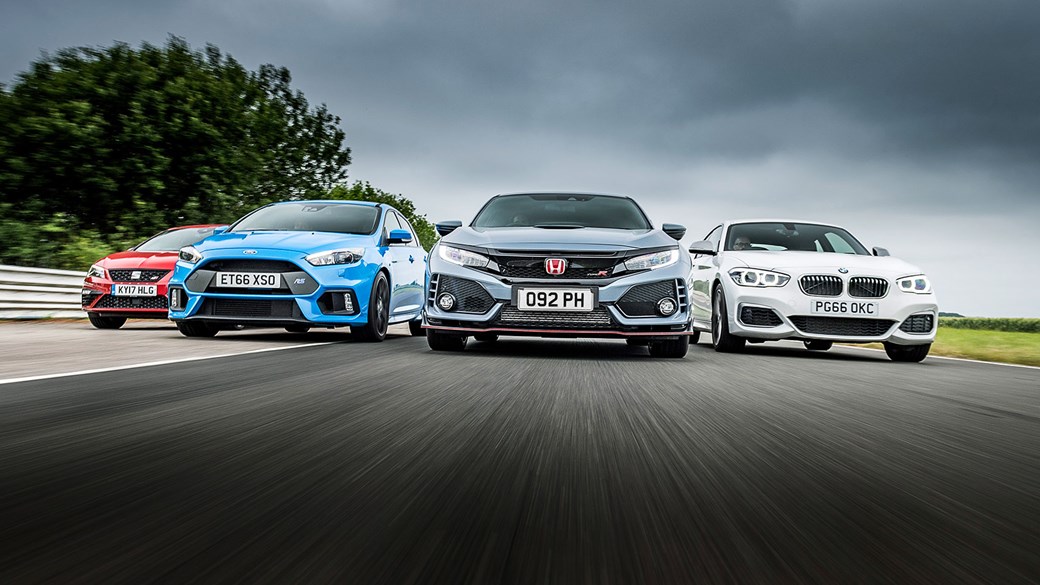
Honda has, in recent years, developed a bit of a reputation for mucking about. Just look at the state of its Formula 1 engine programme, or the amount of time it took for the current NSX to finally see the light of day. Or even how long it made us wait for a Type R to crown the previous generation of Civic.
There has been no such dallying this time around. Mere months after launching the 10th generation Civic and – boom! – here’s the new Type R, on the road, in the UK (where it’s built, of course) and squaring up to three fantastically divergent rivals, all of which sit happily under the broad hot hatch umbrella.
Presumably it helped the development process that the 2.0-litre turbocharged engine is an evolution of the last one, rather than something that needed building from scratch, but you also sense this car has been forged in fire by a Honda that’s determined to prove a point. The heat involved in this process may also explain the slightly melty looking rear bumper.
Honda Civic Type R vs Ford Focus RS vs BMW M140i vs Seat Leon Cupra 300
Still, with 316bhp, 295lb ft, plus a body structure that’s 16kg lighter and 37% stiffer than before – all the better for making use of the now three-stage adaptive damping – this is not a car to be trifled with. Fortunately, such is progress that it isn’t too hard to round up enough suitably potent competition these days, with the BMW M140i, Ford Focus RS and Seat Leon Cupra 300 on hand here, each proudly sporting not just a lot of horsepower but also a great many other virtues.
- Read our full Ford Focus RS review
- We test the Honda Civic Type R
- BMW M140i UK road test
- Seat Leon Cupra 300 UK review
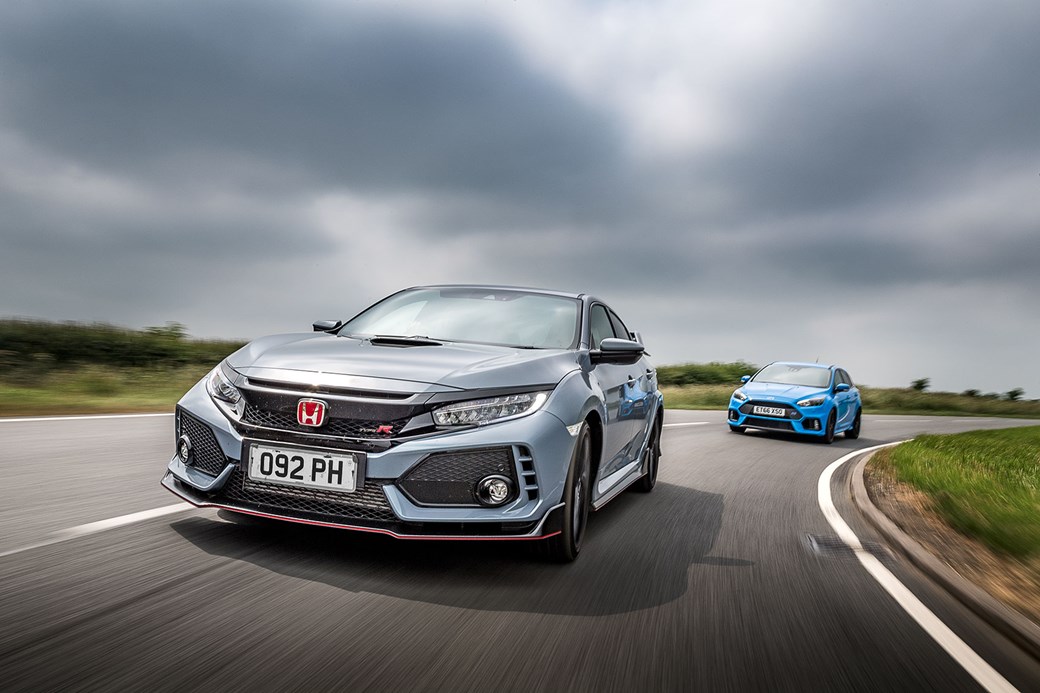
The creeping déjà vu you have about this trio isn’t in your imagination – all three butted heads in last month’s Quick Group Test. You’d be forgiven for thinking their finishing order was therefore a foregone conclusion, but with some differences in spec and the Type R’s arrival throwing the whole sector into sharp relief, honestly, nothing is certain.
Because what is a hot hatch to you? Can we describe the category as encompassing any compact family holdall with a big engine and a tweaked chassis, or should the idea be more tightly defined than that? Does a proper hot hatch have any particular driving characteristics? Should its appearance be subtle for stealth, or should it be unashamed and shout about it?
Leaving nothing to chance, we’ve covered all bases by pitting the Honda against three repeat contenders that not only cover front-wheel drive, rear-wheel drive and all-wheel drive, they also glory in very different characters.
RS: a very fast Focus
The Focus, for example, is the car your mother warned you about – the one that’s going to get you into trouble. Not since the Mitsubishi Evo’s heyday has so much performance potential been crammed into such a mundane basic vessel. While the 345bhp 2.3-litre is the most powerful engine here, it’s the extraordinary all-wheel-drive system, with its individually clutched rear wheels, that turns one of the most common cars in Britain into a genuine giant slayer.
This didn’t stop it losing out to the rear-wheel drive M140i last time around. But not every M140i is the same: the BMW on test today doesn’t have eight-speed sport automatic transmission and adaptive M suspension – it’s bone-stock, with the standard row-your-own six-speed gearbox and conventional dampers. If it wasn’t for the blue M Sport brake calipers and Ferric Grey detailing, it would pass for a regular 1-series.
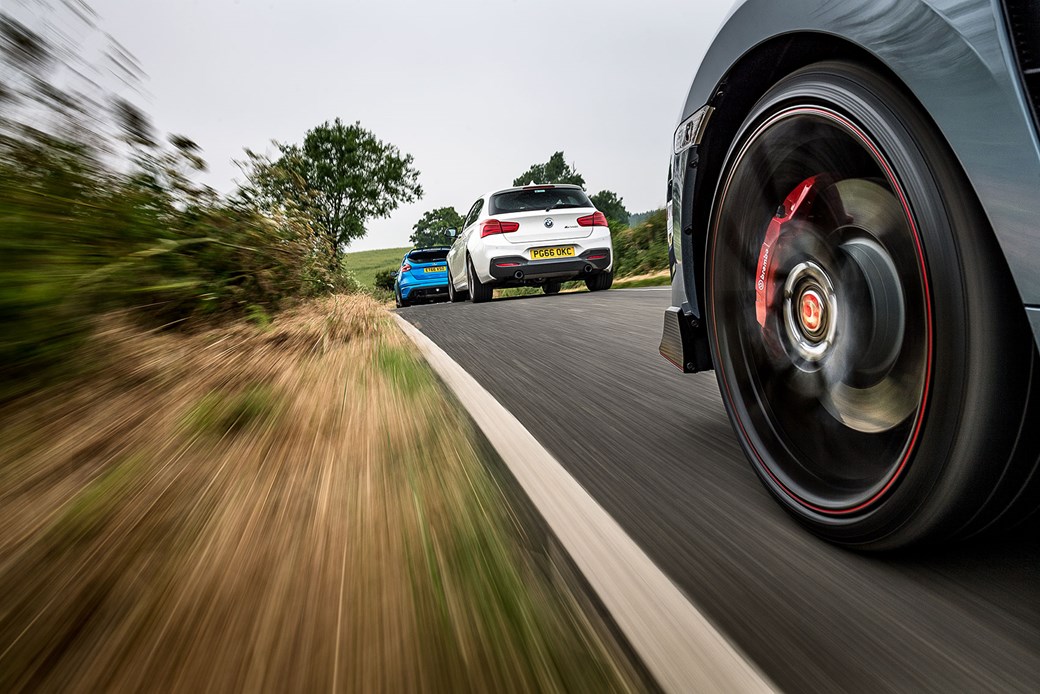
It is by far the most grown-up choice in this group, both to drive and to look at. After only a few miles at the wheel I find myself wondering: do you buy one of these because you want a hot hatch, or because you want a small BMW? Maybe that’s a dubious distinction.
It’s certainly making some kind of a statement, whereas the Seat seems intent on merging with the background. This Leon sits on 18-inch wheels and wears £650’s worth of ‘special’ Desire Red paint, yet still looks like we’ve booked a rental car by accident. If it was a superhero it would be the Invisible Man, and all it seems to be saying to those fellow enthusiasts who do notice it is that the owner couldn’t afford a Golf R. This very anonymity is a tool it wields to tremendous effect, however, because it is still a stupidly fast family car, capable of blitzing much of the motoring landscape before anyone has even clocked its presence. If you like keeping a low profile this has much in its favour.
Which brings us back to the new boy. The Type R doesn’t so much nail its colours to the mast as produce them in triplicate, outline them in neon, sound a klaxon and then set the whole lot on fire. It’s a fine balance between making an impression and trying too hard, and I fear Honda’s sense of direction needs recalibration. What a confused mass of pseudo-carbonfibre and glued-on plastic vortex generators; the only thing more hilarious than the number of vents in the bodywork is that most of them appear to be non-functional.
The designers do seem to have taken their cues from a diverse range of sources – the triple tailpipes and ludicrous rear wing (below) could almost be homage to the Ferrari F40, but the overall look is manga meets Transformers.
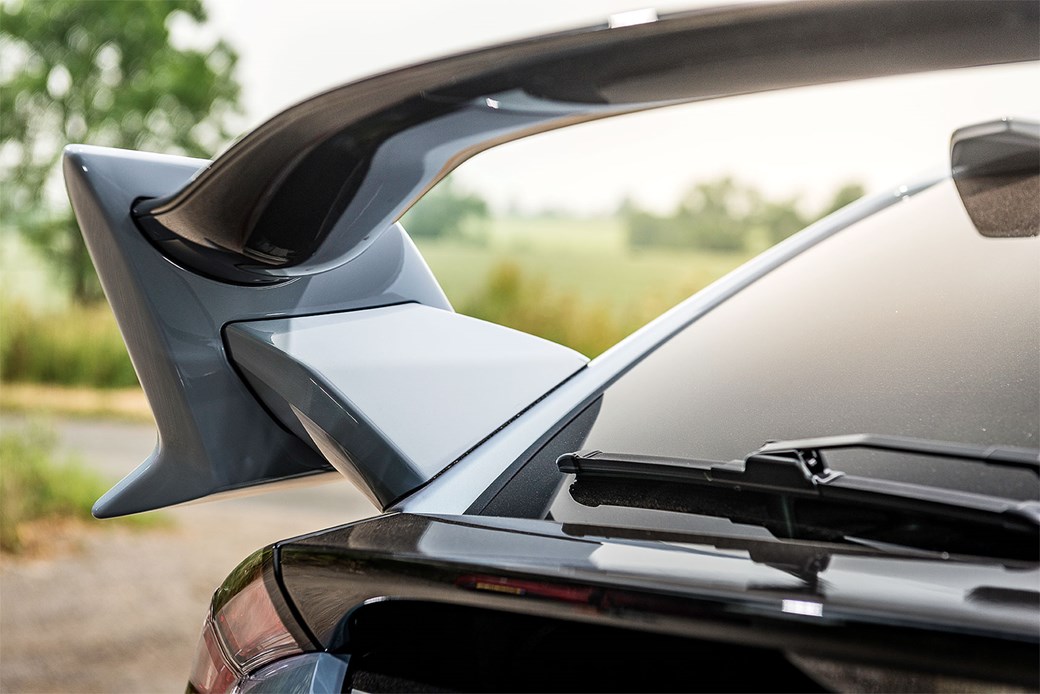
If the Type R turned out to be a talking robot in disguise, I suspect nobody would be surprised; hell, it already does the talking part anyway, with a slightly severe-sounding disembodied female voice murmuring from the dashboard should you foolishly leave a seatbelt undone or fail to release the electronic handbrake. Praise be to the god of British Leyland, for the Austin Maestro has returned to guide us.
The very best thing about that wing is it’s so large it doesn’t disrupt the view through the rear window from the driver’s seat. While the outside is about as subtle as a Club 18-30 holiday, the inside borders on tasteful. Okay, so there is a lot of red highlighting, but these are traditional Type R hallmarks in a manner not far removed from the tartan seats in a Golf GTI; ditto the classic unsullied sphere of satin metal that serves as a gearknob, demanding such reverence I remove my wedding ring to avoid accidentally scratching it. Red dodabs aside, it’s an unfussy cabin in marked contrast to the previous Civic.
Inside the new 2017 Honda Civic Type R
Said gearknob is connected to a sublime shift action – this is a Honda, after all, and one that now also features rev matching. Compared to the last Type R this new model manages to be more civilised without entirely trading away the clear and present sense of single-minded purpose. Which is to say the new Type R feels very much like a car built to go as quickly as possible around a particular piece of scenic German toll road.
Indeed, you probably already know a ‘prototype’ claimed a new front-wheel-drive Nürburgring record of 7min 43.8sec earlier this year (and rumour has it there were subsequent unofficially timed laps that disappeared even faster).
Yet on UK roads you have to dial yourself into the Honda, as first impressions can leave you cold. The suspension defaults to the middle Sport setting, which batters at you like a toddler in a strop over rougher surfaces without seeming to quite deliver on the assertive promise of that exterior; crank the selector upwards into +R mode, and then you’ll find yourself sparring with a partner that will occasionally give you a smarting shot to the kidneys.
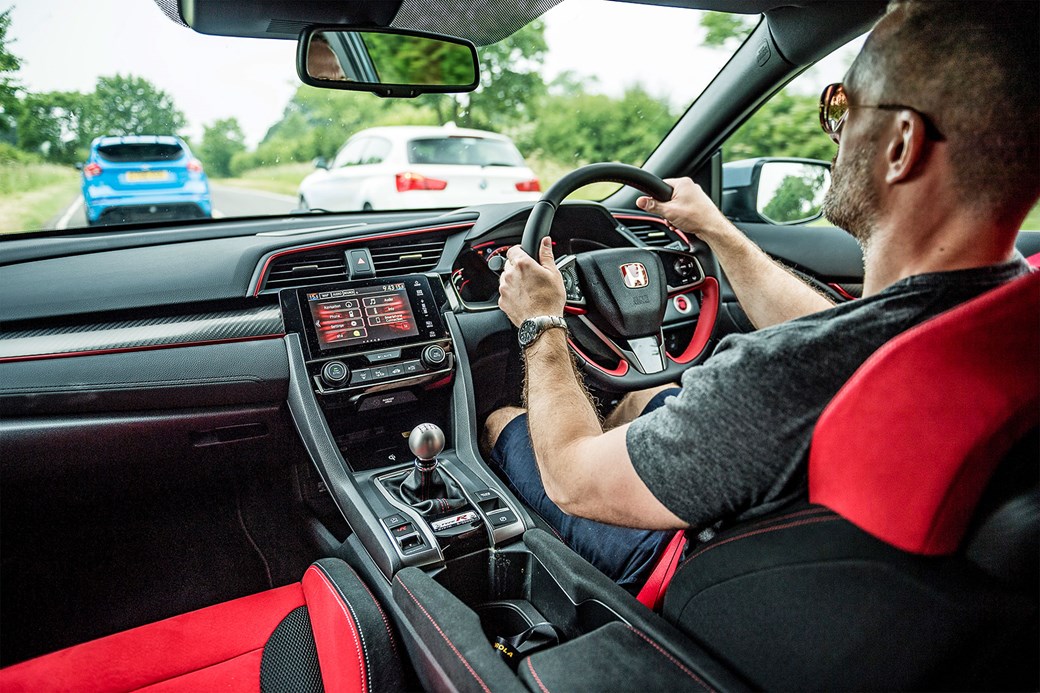
With 20-inch alloys as standard, such hits are fierce enough that you soon start to get nervous about how the car will react if you encounter a bump while braking from speed into trickier turns, an instinct that swiftly proves useful to your self-preservation. Retreat to the Comfort setting, and the Type R becomes almost floaty, a sensation initially at odds with the hardcore visuals, the sharpness of the steering and the manic, boost-heavy delivery of the engine.
You’ll miss that intensity as soon as you hop into the Cupra. Compared to the Type R – and everything else here, in fact – the Leon feels like a woolly blanket. There’s no balance or precision to any of the controls, most notable in the contrasting weighting to the pedals, a shift action that’s achingly ponderous versus the supercar-snick of the Civic, and steering that stays numb and remote no matter which of the driving modes you’ve selected. The height of the seats is like a dining room chair compared to the Honda’s low-slung recliners.
It too gets adaptive suspension as standard, and, to its credit, none of the Leon’s settings over-reach themselves in the UK – you can leave it in the hardest Cupra mode permanently if you wish, and the only punishment for the tauter control this brings to the corners is an exacerbation of the constant jiggle and oddly hollow resonance that’s still present in the lesser Comfort and Sport.
Sport is where it shows the most personality, with a muted yet distinct crackle and pop from the exhaust that disgraces the angry vacuum cleaner routine of the Civic Type R.
Seat Leon Cupra 300 review: rapid but anodyne?
And for all that it’s a little distant, as if lacking the honing that would bring a truly sharpened edge, it would be unfair to dismiss the Leon as dull or unworthy. The interior is by far the nicest of any Seat I’ve ever had the pleasure of driving, and you’d be a fool to mistake its lighter, less demanding touch for an absence of performance. Typical of a fast VW Group product, the Cupra excels at flattering even the most ham-fisted of pilots, and it is seemingly impossible to over drive it.
Traction – at least in the dry – is huge, no matter the 280lb ft the 2.0-litre turbo is feeding to the front wheels, and the throttle response defies the woolliness elsewhere to be almost astonishingly crisp, helped no doubt by the entire maximum torque output being available all the way from 1800 to 5500rpm. It is effortless and unflappable, and many will believe it fulfils their every requirement.
It hardly takes a moment at the wheel of the Focus to appreciate what the Leon is missing. Involvement. The RS is undeniably a tougher car to live with; the bodykit and the badge bring plenty of baggage, the interior’s a black hole with a supplementary gauge pod and minimal-effort blue stitching, and the suspension is firm enough to make you think long and hard about whether it’s worth it.
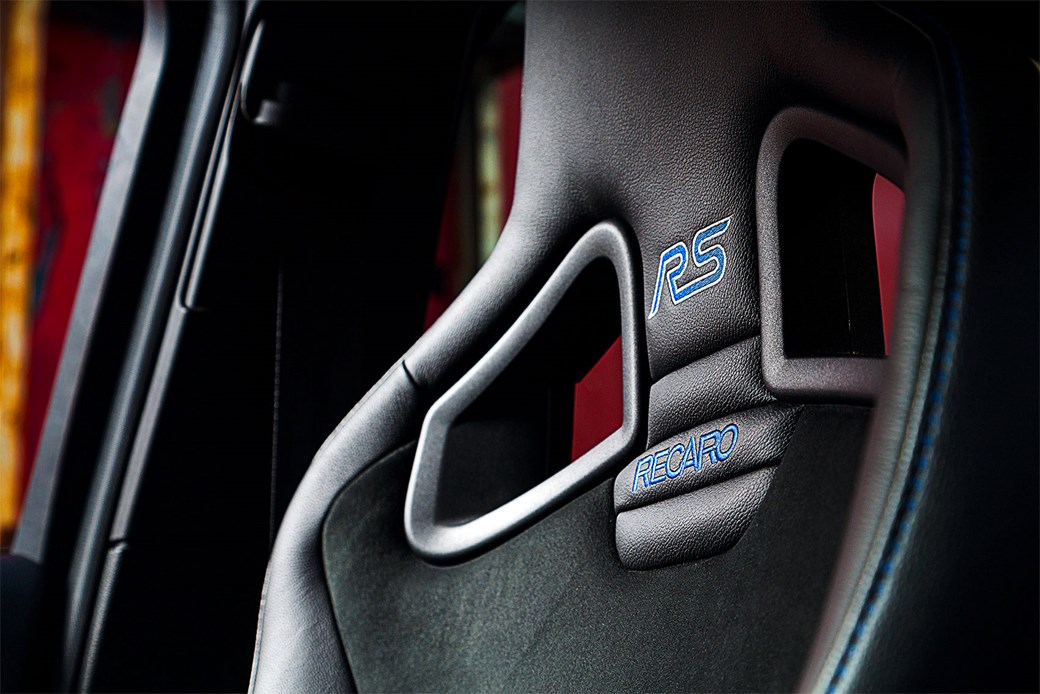
In the end, like the current Fiesta ST, you come to terms with this on the basis that it is so obviously doing a great job of regulating the car’s response to the road, a sentiment reinforced by the way it doesn’t get upset by sudden surface disturbances in the manner of the Civic. You may still feel the lumps, but the repercussions are dealt with in a single stroke of the dampers – control that’s intrinsic to the Ford’s primary directive: making a mockery of physics.
That may be a cliché, but it’s true. If you haven’t driven a Focus RS you may struggle to believe the voodoo Ford has pulled off here. Torque vectoring by brake combined with driven rear wheels that can be individually manipulated according to some arcane algorithms? It’s all cheating as far as the purists are concerned – and at times it is apparent from the driver’s seat that the car absolutely has more talent than you do. Yet you can fling this Ford down the road – any road – with what would otherwise be reckless abandon, and not just survive, not just enjoy, but embrace and revel in every second of the experience.
Who cares how much computer code is involved when it results in a car with such biddable, adaptable poise. Forget about the notorious Drift mode. That may as well be fictional for all the use it is on the Queen’s highway. Much the same is true of the super-hard Sport damper setting, which activates a different load path in the shock absorbers rather than any kind of adaptive capability, making them 40% stiffer. The Sport drivetrain is engage separately from the damper settings. As as well as amping up the throttle and adding a touch of heft to the steering it also gives the exhaust permission to do its best impression of a WRC car. It’s like calling the police before you break the speed limit.
Not that the engine needs much artificial encouragement, being both more powerful and more linear than the Honda’s, and better to listen to. You’ll run to the redline again and again, RS logo upshift light flickering as if to affirm you’re now an authentic fast Ford club member. The gearshift is relatively good too; not as short or exact as the Type R’s, but more on side during rapid transit than either of the other contenders. Some won’t like the way the front wheels are constantly nibbling at the tarmac, though, threatening at any moment to mutiny into tramlining.
It’s not hard to understand how the M140i won the last encounter. Its maturity shines through in this contest – the interior is a step beyond the best of the rest (although not outstanding judged against other BMWs), the engine has 50% more cylinders, and many experts (in the pub, on the TV) will tell you it’s the only one of these cars that’s right-wheel drive.
Sending power to the rear alone, they’ll say, leaves the steering uncorrupted for maximum purity while also allowing you to steer on the throttle. That the next hot 1-series will be a front-wheel-drive four-pot also pressurises you to capitulate, as if David Attenborough is in your ear, whispering ‘last chance to buy’.
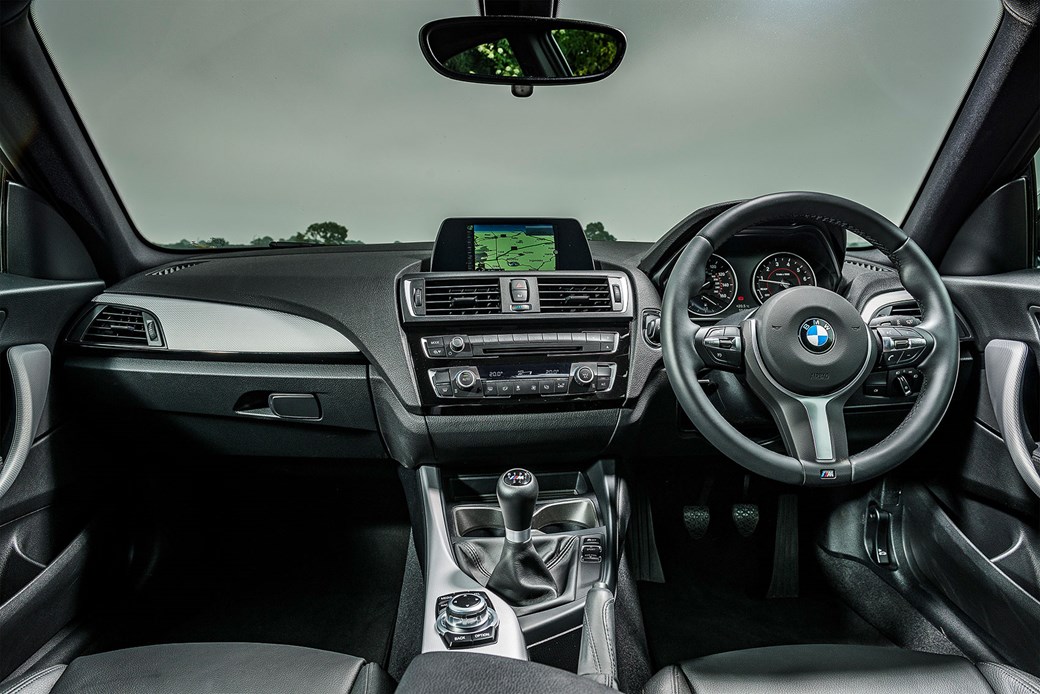
There’s no arguing with the 3.0-litre 335bhp straight-six – it’s a hammer, and a big one. Commit the pedal to the bulkhead, and beyond 5000rpm it launches like a rocket. Combined with BMW’s sweetly calibrated eight-speed auto it’s a force to be reckoned with, so it’s a shame about the slightly crotchety six-speed manual on our car, chosen for price parity. Even with automatic rev-matching on the downshifts you have to think about the process – though you could argue that a powerful rear-wheel-drive car should demand that you build a relationship gradually. Grip is ultimately very high, but with a short wheelbase and 369lb ft from as low as 1520rpm it doesn’t pay to become complacent.
You have to rag the life out of the M140i to get any kind of feedback from the front of the car. Oh, true, it is beautifully balanced across the axles – it’s just that the maturity mentioned earlier translates into steering so light and aloof that it really does feel more like a small BMW than a furious family fireball. No issue if that floats your boat, but in this group it’s the car I would end up driving the slowest. I’m not keen on the niggling chop of the passive M Sport suspension when cruising, either. So it might be mature but it’s not necessarily cossetting.
Back to the Civic. Each of these alternatives exposes some weakness in the Honda. The Leon’s engine is crisper, its manner more relaxed. The RS is faster, better controlled yet more playful. The BMW is – how shall we put this? – more cultured. Yet the more I drive the Type R the more I come to understand and to like it. At odds with that outrageous exterior, it works best in Comfort on the road, and when taken not to the ragged edge but just short of it.
Whooshy, raw, reward… it’s the Honda Civic Type R
There may be finite differences in the throttle mapping and steering weight between the driving modes, but whatever the setting it still has a convincingly communicative helm and it still fizzes with pent-up potential from standstill; the variance in body roll certainly won’t have you breaking out the travel-sickness pills.
It reminds me in many ways of an old Renault Sport Megane – the whooshy turbo, the rawness, the reward for personal precision. It will also light up the traction control warning all the way through the first three gears in the dry, such is the urgency of that uprated 2.0-litre, and although front-wheel-drive only, there’s less of a tendency towards tramlining than there is in the Focus. Yet despite swiftness of shift, it’s nearly impossible to keep the Type R on maximum boost when racing up the ratios, and the engine feels by far the most stressed and laggy.
The Leon serves a purpose, but it’s too non-committal to win here – fast without fervour, it’s a car that seems unlikely to establish a strong emotional bond with its custodian. The Type R puts emotions at the forefront with its ridiculous appearance, then tries to soften you up with some newfound civility. But close as it comes to excellence with its gearbox and single-minded pursuit of performance, the engine’s the hardest work and the chassis lacks deftness. There will be hot hatch buyers out there for whom it becomes a totem worthy of their worship – and good on them. The rest of us, meanwhile, will continue to struggle to stop giggling.
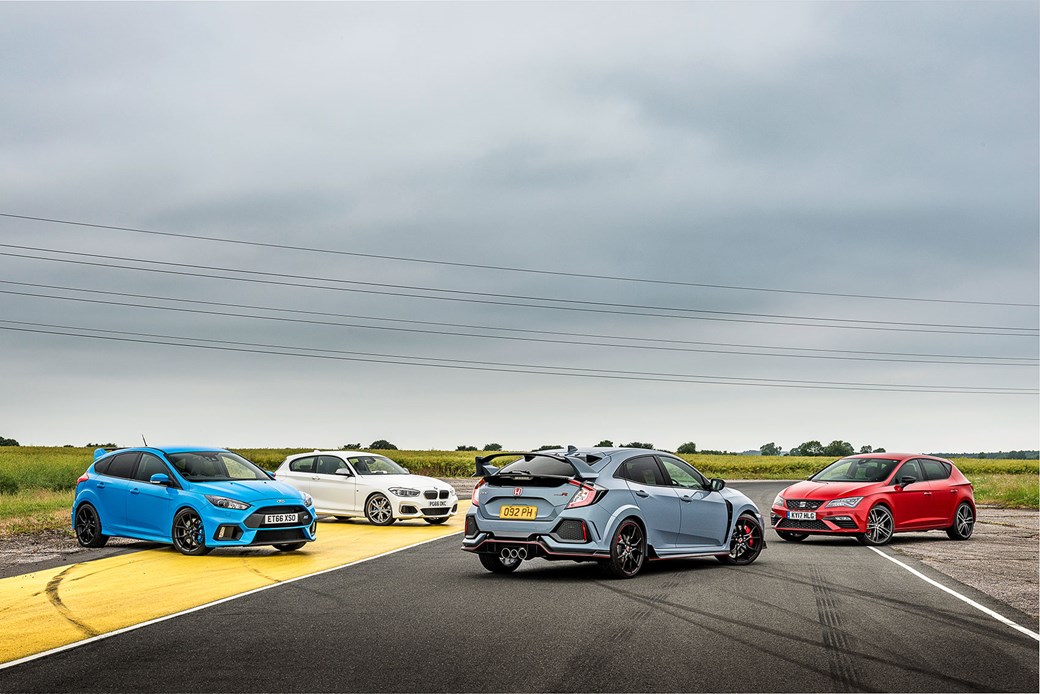
This leaves us with the BMW and the Ford. I understand how the M140i won last time, I really do. That engine, the rear-wheel-drive balance, the more sophisticated image. It just doesn’t speak to me in the way I think a hot hatch ought to.
The Focus RS gives you fun at any speed. With an interactive intensity led by the information provided by the front wheels twitching the steering in your hands and completed by the decisiveness deployed by the rears, it scrabbles for everything it can extract from the engine and the road surface. It does so in a way that makes sense to long-time hot hatch enthusiasts; it feels like an evolution of the species rather than a substitute or a betrayal.
How Ford has managed to make a system so complex seem so natural is beyond my comprehension, but this is one of the most impressive technological achievements in any car at any price, and you don’t have to understand it to enjoy it.
[“Source-carmagazine”]
